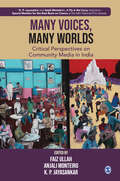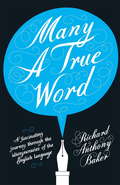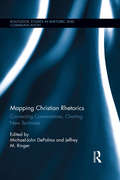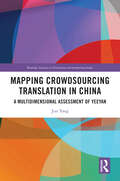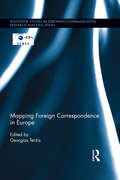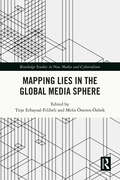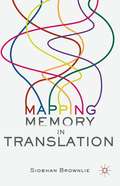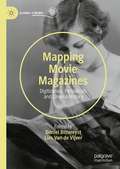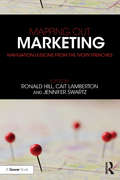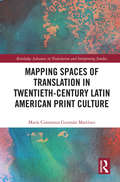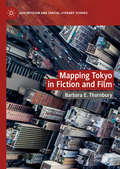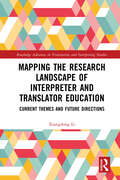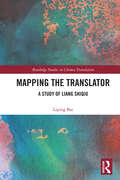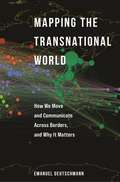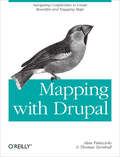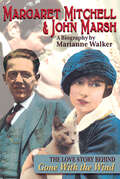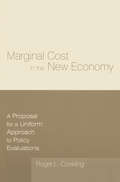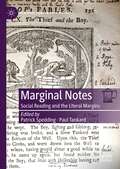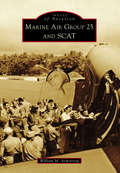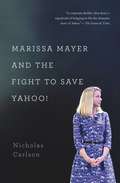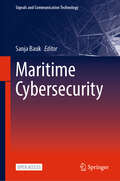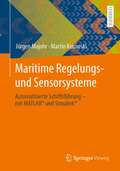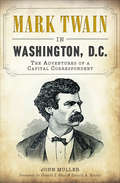- Table View
- List View
Many Voices, Many Worlds: Critical Perspectives on Community Media in India
by Faiz Ullah Anjali Monteiro K. P. JayasankarCommunity media has the potential for deepening democracy by creating spaces for people to raise and discuss their concerns. However, its practice in India tends to be based on top-down decision-making, which is the legacy of the Development Communication paradigms, thus ignoring the creative and transformative possibilities of marginalized community voices. The perspectives in this book, rooted in years of fieldwork experience, by scholars and practitioners of community media, both question and offer alternatives to the dominant paradigms. Many Voices, Many Worlds: Critical Perspectives on Community Media in India is a critical reflection on governance and policymaking, development, disability, knowledge and other social markers in the context of community media. Bringing together different modes of community media—such as video, radio, theatre, information and communication technologies (ICTs) and new media—into a productive conversation with each other, the book focuses on how communities through their communicative practices, negotiate the politics of caste, class, gender, and access to funding and technology.
Many a True Word
by Richard Anthony BakerWhat are the top one hundred words we use the most? How should anchovy, chastisement and tryst be pronounced? How good are you at spelling the most commonly misspelt words and names? For the answers to these andquestions and much more, sit back and let Richard Anthony Baker take you on a journey through the English language.Marvel at the richness of what we derive from French and German; bristle at the words banned in the Daily Telegraph; laugh at the officialese of corporate writers; bone up on our use of language from William Shakespeare (and the Bible) in our day-to-day talk; absorb Richard's master classes on how to win at Scrabble with devastating ease and how to complete cryptic crosswords with impressive alacrity; and test your linguistic agility by trying to answer the five questions which Google puts to job applicants.
Mapping Christian Rhetorics: Connecting Conversations, Charting New Territories (Routledge Studies in Rhetoric and Communication)
by Jeffrey M. Ringer Michael-John DePalmaThe continued importance of Christian rhetorics in political, social, pedagogical, and civic affairs suggests that such rhetorics not only belong on the map of rhetorical studies, but are indeed essential to the geography of rhetorical studies in the twenty-first century. This collection argues that concerning ourselves with religious rhetorics in general and Christian rhetorics in particular tells us something about rhetoric itself—its boundaries, its characteristics, its functionings. In assembling original research on the intersections of rhetoric and Christianity from prominent and emerging scholars, Mapping Christian Rhetorics seeks to locate religion more centrally within the geography of rhetorical studies in the twenty-first century. It does so by acknowledging work on Christian rhetorics that has been overlooked or ignored; connecting domains of knowledge and research areas pertaining to Christian rhetorics that may remain disconnected or under connected; and charting new avenues of inquiry about Christian rhetorics that might invigorate theory-building, teaching, research, and civic engagement. In dividing the terrain of Christian rhetorics into four categories—theory, education, methodology, and civic engagement—Mapping Christian Rhetorics aims to foster connections among these areas of inquiry and spur future future collaboration between scholars of religious rhetoric in a range of research areas.
Mapping Crowdsourcing Translation in China: A Multidimensional Assessment of Yeeyan (Routledge Advances in Translation and Interpreting Studies)
by Jun YangYang explores the use of crowdsourcing in translation within the Chinese context, focusing on Yeeyan – the largest online translation community in China. As one of the world’s largest markets for language content consumption, China experiences significant demand for translation services. Yeeyan, a pioneer among amateur translation communities in China, offers an autonomous environment where the public collectively determines the content they wish to import from foreign languages.The book conducts a holistic evaluation of crowdsourcing translation using a multidimensional analytical framework, emphasising the interrelations among agents, processes, products, and crowdsourcing environments. Using the Yeeyan community as a case study, the book investigates the motivations behind participation in Yeeyan, the quality of translations produced, the extent to which this quality can be controlled, and how learning occurs through their participation. The analysis includes the two primary types of projects facilitated by Yeeyan – article translation for knowledge-sharing and book translation for commercial publication. Additionally, Yang explores the emerging field of crisis translation - assessing the applications of crowdsourcing in disaster contexts and exploring the ethical implications involved. Drawing on empirically informed results, the book proposes recommendations for the effective design and organisation of crowdsourcing translation projects and elucidates how such initiatives can be optimally utilised in both translation production and translation training endeavours.This book is a valuable contribution to the field of translation studies, offering a detailed examination of crowdsourcing translations and the participatory culture of the Chinese internet.
Mapping Foreign Correspondence in Europe (Routledge Studies in European Communication Research and Education)
by Georgios TerzisThe book studies the current trends of foreign correspondence in Europe. The EU’s expansion has had abundant effects on news coverage and some of the European capitals have become home to the biggest international press corps in world. So, who are these "professional strangers" stationed in Europe and how do they try to make their stories, that are clearly important in today’s interconnected world, interesting for viewers and readers?This book represents the first Pan-European study of foreign correspondents and their reporting. It includes chapters from 27 countries, and it aims to study them and the direction, flow and pattern of their coverage, as well as answer questions regarding the impact of new technologies on the quantity, frequency and speed of their coverage. Do more sophisticated communications tools yield better international news coverage of Europe? Or does the audience’s increasing apathy and the downsizing of the foreign bureaus offset these advances? And how do the seemingly unstoppable media trends of convergence, commercialization, concentration, and globalization affect the way Europe and individual European countries are reported?
Mapping Lies in the Global Media Sphere (Routledge Studies in New Media and Cyberculture)
by Tirşe Erbaysal-Filibeli Melis Öneren-ÖzbekThis volume addresses the concept of “(in)nocent lies” in the media – beyond the concept of misleading information online, this extends to a deliberate effort to spread misinformation, disinformation and conspiracy theories – and proposes a critical approach to tackle the issue in related interdisciplinary fields. The book takes a multidisciplinary and international approach, addressing the digital divide and global inequality, as well as algorithmic bias, how misinformation harms vulnerable groups, social lynching and the effect of misinformation on certain social, political and cultural agendas, among other topics. Arranged thematically, the chapters paint a nuanced and original picture of this issue. This book will be of interest to students and academics in the areas of digital media, media and politics, journalism, development studies, gender and race.
Mapping Memory in Translation
by Siobhan BrownlieThis book presents a map of the application of memory studies concepts to the study of translation. A range of types of memory from personal memory and electronic memory to national and transnational memory are discussed, and links with translation are illustrated by detailed case studies.
Mapping Movie Magazines: Digitization, Periodicals and Cinema History (Global Cinema)
by Daniel Biltereyst Lies Van de VijverMovie magazines are crucial but widely underused sources for writing the history of films and cinema. This volume brings together for the first time a wide variety of historic research of movie magazines and film trade journals, reflecting on the issue of using these sources for film/cinema historiography and on the impact of digitization processes. Mapping Movie Magazines explores this debate from different disciplinary perspectives, enlightened by case studies from the use of early film trade press to pedagogical uses of digitized periodicals. The volume explores Hollywood’s grip on movie magazines, gender in film journalism, typologies of unknown trade press and movie magazine markets, and subversive Tijuana bibles.
Mapping Out Marketing: Navigation Lessons from the Ivory Trenches
by Ronald Hill, Cait Lamberton and Jennifer SwartzSea-changes in society, technology, consumer expectations and our understanding of behavioral economics have caused us to rethink our understanding of the scope of knowledge required to navigate, analyze and shape consumer behavior. You hold in your hand a field guide for this adventure. Ron Hill and Cait Lamberton have gathered together the very top professors from around the world and invited them to share the beliefs, practices and wisdom that they have developed and honed across years and contexts. Each of these luminaries shares personal stories and deep insights about the way that not only business works, but the way we, ourselves, navigate the world. These short contributions are contained in eight "destinations" that showcase overlapping and essential topics, ranging from technology to subsistence marketplaces, followed by unique questions that are answered by the material provided. The research described has helped the field understand the central role of exchange in marketing relationships, and how product features, pricing strategies, delivery mechanism and various communication modalities create or fail to produce functioning marketplaces around the world. In addition, it reminds us all of the need to continue to learn, to grow, and to share our knowledge – in whatever corner of the marketing world we find ourselves.
Mapping Spaces of Translation in Twentieth-Century Latin American Print Culture (Routledge Advances in Translation and Interpreting Studies)
by María Constanza GuzmánThis book reflects on translation praxis in 20th century Latin American print culture, tracing the trajectory of linguistic heterogeneity in the region and illuminating collective efforts to counteract the use of translation as a colonial tool and affirm cultural production in Latin America. In investigating the interplay of translation and the Americas as a geopolitical site, Guzmán Martínez unpacks the complex tensions that arise in these “spaces of translation” as embodied in the output of influential publishing houses and periodicals during this time period, looking at translation as both a concept and a set of narrative practices. An exploration of these spaces not only allows for an in-depth analysis of the role of translation in these institutions themselves but also provides a lens through which to uncover linguistic plurality and hybridity past borders of seemingly monolingual ideologies. A concluding chapter looks ahead to the ways in which strategic and critical uses of translation can continue to build on these efforts and contribute toward decolonial narrative practices in translation and enhance cultural production in the Americas in the future. This book will be of particular interest to scholars in translation studies, Latin American studies, and comparative literature.
Mapping Tokyo in Fiction and Film (Geocriticism and Spatial Literary Studies)
by Barbara E. ThornburyMapping Tokyo in Fiction and Film explores ways that late 20th- and early 21st- century fiction and film from Japan literally and figuratively map Tokyo. The four dozen novels, stories, and films discussed here describe, define, and reflect on Tokyo urban space. They are part of the flow of Japanese-language texts being translated (or, in the case of film, subtitled) into English. Circulation in professionally translated and subtitled English-language versions helps ensure accessibility to the primarily anglophone readers of this study—and helps validate inclusion in lists of world literature and film. Tokyo’s well-established culture of mapping signifies much more than a profound attachment to place or an affinity for maps as artifacts. It is, importantly, a counter-response to feelings of insecurity and disconnection—insofar as the mapping process helps impart a sense of predictability, stability, and placeness in the real and imagined city.
Mapping the Research Landscape of Interpreter and Translator Education: Current Themes and Future Directions (Routledge Advances in Translation and Interpreting Studies)
by Xiangdong LiMapping the Research Landscape of Interpreter and Translator Education explores research themes in interpreter and translator education based on a systematic review of more than 20 years of research in the field. The book focuses on the ten research themes on the chain of curriculum development and evaluation, specifically, market needs analysis, content conceptualisation, learning needs analysis, teaching objectives, teaching beliefs, syllabus design, material development, instruction and/or effect, assessment, and course evaluation. It also touches upon the other 14 research themes, for example, trainer education, admissions, learner traits, thesis and research training, pre-service preparation, certification, in-service training, client education, and translation and interpreting as a means to education. The discussion of each theme is accompanied by a synthesis of its sub-themes, typical research cases, research prospects, and suggested reading. As a guide, it supports teachers by illustrating how to combine teaching and research in university settings and offers ways to integrate research into pedagogy.This book is a go-to reference for trainers and a hands-on guide for academics, researchers, and postgraduate students specialising in translation and interpreting curriculum development and pedagogy research.
Mapping the Translator: A Study of Liang Shiqiu (Routledge Studies in Chinese Translation)
by Liping BaiIn Mapping the Translator: A Study of Liang Shiqiu, the writer studies Liang Shiqiu (1903–1987), who was not only a famous writer and important critic but also one of the most prominent translators in China in the 20th century, most notably the first Chinese to finish a translation of The Complete Works of William Shakespeare. Based on primary sources, this research covers issues related to the historical, cultural, cognitive and sociological dimensions of translator studies. It investigates Liang’s translation poetics; the influences of possible patrons and professionals on him; the relationship between Liang’s ideology, the dominant ideology and his translation; Liang’s debates with Lu Xun about and beyond translation criteria, and whether there is inconsistency or possible contradiction in Liang’s translation poetics. This book also analyses the similarities and differences between Liang Shiqiu and Wu Mi–two followers of Irving Babbitt–in terms of translation poetics, and further explores the reasons leading to such differences. This book is targeted at scholars and students, both undergraduate and postgraduate, in the fields of translation studies, Asian studies, Chinese studies, and literary studies.
Mapping the Transnational World: How We Move and Communicate across Borders, and Why It Matters (Princeton Studies in Global and Comparative Sociology)
by Emanuel DeutschmannA study of the structure, growth, and future of transnational human travel and communicationIncreasingly, people travel and communicate across borders. Yet, we still know little about the overall structure of this transnational world. Is it really a fully globalized world in which everything is linked, as popular catchphrases like “global village” suggest? Through a sweeping comparative analysis of eight types of mobility and communication among countries worldwide—from migration and tourism to Facebook friendships and phone calls—Mapping the Transnational World demonstrates that our behavior is actually regionalized, not globalized.Emanuel Deutschmann shows that transnational activity within world regions is not so much the outcome of political, cultural, or economic factors, but is driven primarily by geographic distance. He explains that the spatial structure of transnational human activity follows a simple mathematical function, the power law, a pattern that also fits the movements of many other animal species on the planet. Moreover, this pattern remained extremely stable during the five decades studied—1960 to 2010. Unveiling proximity-induced regionalism as a major feature of planet-scale networks of transnational human activity, Deutschmann provides a crucial corrective to several fields of research.Revealing why a truly global society is unlikely to emerge, Mapping the Transnational World highlights the essential role of interaction beyond borders on a planet that remains spatially fragmented.
Mapping with Drupal: Navigating Complexities to Create Beautiful and Engaging Maps
by Alan Palazzolo Thomas TurnbullBuild beautiful interactive maps on your Drupal website, and tell engaging visual stories with your data. This concise guide shows you how to create custom geographical maps from top to bottom, using Drupal 7 tools and out-of-the-box modules. You’ll learn how mapping works in Drupal, with examples on how to use intuitive interfaces to map local events, businesses, groups, and other custom data.Although building maps with Drupal can be tricky, this book helps you navigate the system’s complexities for creating sophisticated maps that match your site design. Get the knowledge and tools you need to build useful maps with Drupal today.Get up to speed on map projections, the ethics of making maps, and the challenges of building them onlineLearn how spatial data is stored, input by users, manipulated, and queriedUse the OpenLayers or GMap modules to display maps with lists, tables, and data feedsCreate rich, custom interactions by applying geolocationCustomize your map’s look and feel with personalized markers, map tiles, and map popupsBuild modules that add imaginative and engaging interactions
Margaret Mitchell & John Marsh: The Love Story Behind Gone With the Wind
by Marianne WalkerBased on almost 200 previously unpublished letters and extensive interviews with their closest associates, Walker's biography of Margaret Mitchell and her husband, John Marsh, offers a new look into a devoted marriage and fascinating partnership that ultimately created a Pulitzer Prize–winning novel. This edition of Walker's biography celebrates the seventy-fifth anniversary of the publication of Gone With the Wind in 1936.In lively extracts from their letters to family and friends, John and Margaret, who also went by Peggy, describe the stormy years of their courtship, their bohemian lifestyle as a young married couple, the arduous but fulfilling years when Peggy was writing her famous novel, the thrill of its acceptance for publication and its literary success, and the excitement of the making of the movie. In telling the private side of this twenty-four-year marriage, author Marianne Walker reveals a long-suspected truth: Gone With the Wind might have never been written were it not for John Marsh. He was Peggy's best friend and constant champion, and he became her editor, proofreader, researcher, business manager, and the inspiration and motivation behind her writing. At every point, including the turbulent years of Mitchell's first marriage to Red Upshaw, it was John who provided the intellectual stimulation, emotional support, and editorial insights that allowed Peggy to channel her talents into the creation of her astounding Civil War epic. From years of meticulous research, Marianne Walker details the intimate and moving love story between a husband and wife, and between a writer and her editor.
Marginal Cost in the New Economy: A Proposal for a Uniform Approach to Policy Evaluations
by Roger L. ConklingThis volume presents an approach for resolving a variety of public policy debates. It proposes that a single standard - marginal cost methodology - be adopted to replace the haphazard arrays of methods and techniques currenly employed to measure the costs and benefits of disputed policy issues.
Marginal Notes: Social Reading and the Literal Margins (New Directions in Book History)
by Paul Tankard Patrick SpeddingMarginal Notes: Social Reading and the Literal Margins offers an account of literary marginalia based on original research from a range of unique archival sources, from mid-16th-century France to early 20th-century Tasmania. Chapters examine marginal commentary from 17th-century China, 18th-century Britain, and 19th-century America, investigating the reputations, as reflected by attentive readers, of He Zhou, Pierre Bayle, Samuel Johnson, Thomas Warton, and Sir Walter Scott. The marginal writers include Jacques Gohory, Mary Astell, Hester Thrale, Herman Melville, the young daughters of the Broome family in Gloucestershire, and the patrons of the library of the Huon Mechanics’ Institute, Tasmania. Though marginalia is often proscribed and frequently hidden or overlooked, the collection reveals the enduring power of marginalia, concluding with studies of the ethics of annotation and the resurrected life of marginalia in digital environments.
Marine Air Group 25 and SCAT (Images of Aviation)
by William M. ArmstrongMarine Air Group 25 was a pioneering combat air transport unit that entered overseas service during the Guadalcanal campaign in September 1942, helping to achieve the first American offensive victory of the war in the Pacific. It quickly gained fame for its rapid delivery of vital supplies and its lifesaving evacuation of casualties. During the fight for Guadalcanal, Marine Air Group 25 became the nucleus of the joint-service SOPAC (South Pacific) Combat Air Transport Command, or SCAT, partnering with troop carrier and medical units of the US Army Air Forces. SCAT would continue to play a crucial role in subsequent Allied operations throughout the Solomon Islands, including the battles for New Georgia and Bougainville. After SCAT was dissolved in February 1945, Marine Air Group 25 continued its mission in the Philippines and then Northern China until being deactivated in 1946. In 1950, the group was reactivated, seeing further service during the Korean War.
Marissa Mayer and the Fight to Save Yahoo!
by Nicholas CarlsonA page-turning narrative about Marissa Mayer's efforts to remake Yahoo as well as her own rise from Stanford University undergrad to CEO of a $30 billion corporation by the age of 38. When Yahoo hired star Google executive Mayer to be its CEO in 2012 employees rejoiced. They put posters on the walls throughout Yahoo's California headquarters. On them there was Mayer's face and one word: HOPE. But one year later, Mayer sat in front of those same employees in a huge cafeteria on Yahoo's campus and took the beating of her life. Her hair wet and her tone defensive, Mayer read and answered a series of employee-posed questions challenging the basic elements of her plan. There was anger in the room and, behind it, a question: Was Mayer actually going to be able to do this thing? MARISSA MAYER AND THE FIGHT TO SAVE YAHOO! is the inside story of how Yahoo got into such awful shape in the first place, Marissa Mayer's controversial rise at Google, and her desperate fight to save an Internet icon. In August 2011 hedge fund billionaire Daniel Loeb took a long look at Yahoo and decided to go to war with its management and board of directors. Loeb then bought a 5% stake and began a shareholder activist campaign that would cost the jobs of three CEOs before he finally settled on Google's golden girl Mayer to unlock the value lurking in the company. As Mayer began to remake Yahoo from a content company to a tech company, an internal civil war erupted. In author Nicholas Carlson's capable hands, this riveting book captures Mayer's rise and Yahoo's missteps as a dramatic illustration of what it takes to grab the brass ring in Silicon Valley. And it reveals whether it is possible for a big lumbering tech company to stay relevant in today's rapidly changing business landscape.
Maritime Cybersecurity (Signals and Communication Technology)
by Sanja BaukThis book highlights the importance of cybersecurity in the maritime domain, including the human and societal aspects of both cyber-crime and cyber-defense. The authors present mechanisms for early detection and prevention of cyber-attacks, as well as security protocols based on testbed nautical simulator experiments, machine learning algorithms and artificial intelligence applications. This collection of research articles addresses the ethical, societal and technical aspects of maritime cybersecurity and offers solutions to mitigate the threat of cyber-attacks. The book is designed to help both researchers and stakeholders across the maritime ecosystem, including shipping and port logistics. Research findings are presented in the following areas: human factors in maritime cyber security, cyber security awareness and skills of seafarers, vulnerabilities in electronic maritime navigation on manned and unmanned vessels, internal and external attack vectors on bridge and propulsion systems, cyber security threats and countermeasures in seaports. The book serves as a handbook for those professionally involved in or interested in cybersecurity of IT and OT systems. This book is open access, which means that you have free and unlimited access.
Maritime Regelungs- und Sensorsysteme: Automatisierte Schiffsführung – mit MATLAB® und Simulink®
by Jürgen Majohr Martin KurowskiDas Buch beschreibt die erforderlichen Grundlagen für den Entwurf und die Anwendung maritimer Regelungssysteme. Unter Verwendung moderner Methoden der Modellbildung und der Regelungstheorie erfolgt die Behandlung von Navigationssystemen und Sensoren, Regelungsstrukturen und Assistenzsystemen bis hin zu einem neuentwickelten Manöverregelungssystem. Der methodisch dargestellte Stoff wird durch eine Vielzahl von mit MATLAB® und Simulink® erstellten Rechenbeispielen und Simulationen auf der Basis von Borddaten anschaulich interpretiert.
Mark Steyn's Passing Parade: Obituaries And Appreciations
by Mark Steyn...on Bob Hope: He was the first comedian to run himself as a business, and he succeeded brilliantly. Time magazine reported in 1967 that he was worth half a billion dollars. Asked about the figure, Hope said, "Anyone can do it. All you have to do is save a million dollars a year for 500 years." ...on Amin: His Excellency was borne aloft in a sedan chair balanced with some difficulty on the shoulders of four spindly Englishmen from Kampala's business community, while another humbled honky walked behind holding the parasol. When it came to the white man's burden, the British could talk the talk. But that night the 3001b Amin made them walk the walk. ...on Strom Thurmond: Strom had just cast an appreciative bipartisan eye over the petite brunette liberal extremist. Senator Boxer gave an involuntary shudder. Glancing down, I was horrified to see an unusually large lizard slithering up and down my arm. On closer inspection, it proved to be Strom's hand. Presumably he'd mistaken my dainty elbow for Barbara's, but who knows? In how many other national legislatures can a guy just wander in off the street and find himself being petted by a 97-year-old Senator? ...on the Princess of Wales: August is the "silly season" in the British press, and this year the Princess had done her bit for her media chums, embarking on a dizzying summer romance that brought an extravagant array of her lover's ex-girlfriends tumbling out of the cupboard. A good time was had by all. On the very last day of the silly season, when the Queen's subjects woke to the news that Diana was dead, it seemed in some strange way the best plot twist of all. On Katherine Graham judging from the tone of the drooling eulogies, most commentators are apparently assuming that The Washington Post's proprietress will be continuing her salons in the unseen world and that, come their own demise, they want to make sure they're at the top table with Kay, the Kennedys, Pam Harriman, and not down the declasse end near the powder room with God, Christ, St Peter and the other losers. And for This Ole House: I was wandering way up in the mountains and came across this dilapidated cabin." He was hunting in the high Sierras and had noticed a mangy, starving old hound dog hanging around an otherwise abandoned cabin. "Inside, I found an old prospector lying dead. I saw curtains, so that meant a woman had been there. I saw kids' things lin' around. And they were all gone now. The old man was alone." Most of us would just get out, some perhaps would go to the cops, but Hamblen sat down and, with the corpse lying next to him for inspiration, began to rough out a song.
Mark Twain in Washington, D.C.: The Adventures of a Capital Correspondent
by John MullerA rollicking account of how Mark Twain mocked and mined DC&’s self-important, incompetent, and corrupt political scene to further his literary career. When young Samuel Clemens first visited the nation&’s capital in 1854, both were rough around the edges and of dubious potential. Returning as Mark Twain in 1867, he brought his sharp eye and acerbic pen to the task of covering the capital for nearly a half-dozen newspapers. He fit in perfectly among the other hard-drinking and irreverent correspondents. His bohemian sojourn in Washington, DC, has been largely overlooked, but his time in the capital city was catalytic to Twain&’s rise as America&’s foremost man of letters. While in Washington City, Twain received a publishing offer from the American Publishing Company that would jumpstart his fame. Through original research unearthing never-before-seen material, author John Muller explores how Mark Twain&’s adventures as a capital correspondent proved to be a critical turning point in his career. Includes photos! &“Muller&’s careful research, hard facts, well-chosen illustrations, and fresh discoveries bring Twain&’s Washington period back to life.&” —TwainWeb
